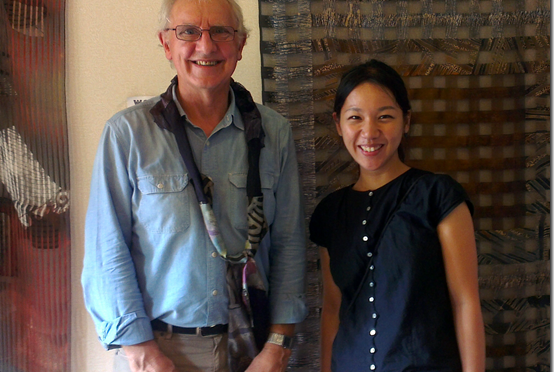
Master batik artist Tony Dyer with a young Japanese textile student at the Semarang International Batik Festival in May 2013
One of the major events of 2014 will be the Golden Jubilee of the World Crafts Council, which will be held in Dongyan, China, 18-22 October. It will be very interesting to see how the Chinese presidency of WCC uses this unique occasion to promote local craftsmanship. One day ‘Made in China’ may be something that actually adds value to a product.
The China event will be an important occasion to present the Code of Practice for Partnerships in Craft & Design, which has been developed over the past three years of discussions that were part of Sangam: Australia India Design Platform. We’ll be developing a platform based around those standards to promote fair partnerships between producers and developers. This year, the network will extend to Indonesia, with a workshop at Kampoeng Semarang looking particularly at commissioning of batik artists.
One of the important elements that draws me to craft is the way it engages with tradition. While the modern world encourages freedom, it is hard to conceive of a meaningful life without responsibility. Custodianship gives meaning to our otherwise fleeting lives. And craft traditions require skill and imagination if that are to be something we can pass on to future generations. This involves interpreting traditions through current concerns. As they say, we make it new, again.
This is something quite evident to indigenous peoples, whose own culture is vulnerable to colonisation. Retaining language and custom gives purpose and honour to individual lives in indigenous communities.
By contrast, the dominant white Anglo world seems to require little from us in order to flourish. It runs increasingly on automatic, sustained by machines and global corporations. But there are still buried traditions that we can uncover and pass on. Colonisation involved removing the social value from objects, otherwise considered the primitive domain of fetish or idol. The challenge is to recover social objects such as charms, crowns, garlands and heirlooms that offer a hard currency of interconnection.

Amulets from the Sonara Market in Mexico City - how to turn objects of destruction into agents of good?
The project Joyaviva: Live Jewellery across the Pacific travels to Latin America this year. It will be very interesting to see how these audiences respond to the challenge of designing a modern amulet. Can folk traditions transcend their nostalgia and become relevant elements of contemporary life?
The broader questions associated with this will be played out in a series of roundtables as part of the South Ways project. This will seek to identify creative practices that are unique to the South. The first one in Wellington will look at the relevance of the Maori ‘power object’, or taonga, to Western art practices such as relational jewellery.
Other projects will help tie these threads together. The performance work Kwality Chai will explore what an Indianised Australia might be like. This relates to the utopia of Neverland, in which Australia becomes a haven for cultures that have no home in the world, such as Sri Lankan Tamils.
Craft keeps us alive to the debt we owe to previous generations. I’m very pleased to be involved with Wendy Ger’s Taiwan Ceramics Biennale where many artists have mastered clay as a language for the unique expression of ideas and values.
So there’s much to be made of 2014. Let’s hope this includes a future for 2015 and beyond.
